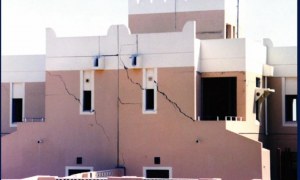🕑 Reading time: 1 minute
A cofferdam is a temporary structure designed and constructed to support ground and keep groundwater or water above ground level away from an excavation. By and large, a cofferdam does not exclude water out of excavation completely since the construction of such type of cofferdam would be highly expensive. Some seepage of water into the excavation is usually well-tolerated and pumped out periodically.
There are several types of cofferdams including earth embankment, rockfill embankment, sandbag embankment, single and double wall timber sheet pile, precast concrete blockwork, precast concrete frame unit, cellular sheet steel piling, bored cast-in-place piling, rock or earth fill timber cribs, flexible sheeting on timber or steel framing, and movable cofferdam.
Different site conditions require different kinds of cofferdams. The factors that govern the choice of a cofferdam for a certain construction site are the water table of that area, type of soil, size and depth of excavation, construction material availability, ease of transportation, water flow velocity, and risk of damage by floating debris.
The presence of certain factors at the construction site leads to the choice of a specific type of cofferdam, for example, earth fill cofferdam is suitable for an area with low water head whereas single-wall sheet pile cofferdam is applicable for restricted site areas where ground anchor or cross bracing can be used.
Contents:
Types of Cofferdams
- Earth embankment
- Rockfill embankment
- Sandbag embankment
- Single wall timber sheet piling
- Double wall timber sheet piling
- Flexible sheeting on timber or steel framing
- Rock or earth fill timber cribs
- Single wall steel sheet piling
- Double wall steel sheet piling
- Cellular steel sheet piling
- Bored cast in place piling
- Precast concrete blockwork
- Precast Concrete frame unit
- Movable cofferdams (structural steel cylinders and shells)



Criteria for Selection of Cofferdam Types
- Depth of water
- Depth and size of excavation
- Soil type
- Velocity of flow in waterway
- Tide levels
- Risk of damage by floating debris or ice
- Availability of construction materials
- Ease of transportation of construction materials
Application Conditions
Each type of cofferdam provides ultimate efficiency and is suitable in certain circumstances. Suitable applicability conditions of common types of cofferdam are discussed below:
1. Earthfill Cofferdam
It is suitable for
2. Single Wall Sheet Pile Cofferdam
This type of cofferdam is applicable for restricted site areas where ground anchor or cross bracing can be used. It is not suitable for areas containing high quantity of boulders.
3. Double Wall and Cellular Sheet Piling
They are suitable for wide excavations where self-supporting dams are needed.

4. Rock or Earthfill Timber Cribs
These are commonly constructed in a remote site in undeveloped areas where timber in bamboo or log form are available, and import and transfer of sheet pile and necessary plant to handle and drive it is astronomically high.
5. Timber Sheet Pile Cofferdam
It is used in the areas where timber is readily available and is suitable for low head water.
Advantages of Cofferdams
- Allow excavation and construction of structures in an otherwise poor environment
- Provide a safe environment to work
- Contractors typically have design responsibility
- Steel sheet piles are easily installed and removed
- Materials can typically be reused for other projects
Disadvantages of Cofferdams
- Special equipment is required
- Relatively expensive
- Very time consuming and tedious process of construction
- If rushed, sheets can be driven out of locks or out of plumb
- When in flowing water, 'log jams' may occur creating an added stress on the structure


